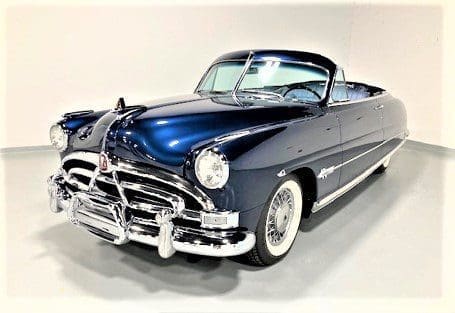
1951 saw the introduction of the Hornet in the Hudson model lineup. The Hornet featured Hudson’s popular “Monobuilt” or “step-down” design that had debuted a few years earlier on the 1948 Hudson Commodore. The term “step-down” is derived from the way the floor pan was recessed between the cars chassis rails instead of the conventional design of sitting on top of the frame, so you stepped down into a Hudson. This overall unitized design lowered the cars center of gravity making it both functional and stylish. 1951 Hudson Hornets were powered by a L-Head 308 CID six-cylinder engine that at the time was the largest (displacement) six-cylinder engine being mass produced. In November of 1951 Hudson introduced the “Twin-H” twin one-barrel carburetor set up that was a dealer installed option on 1951 models and a factory option beginning in 1952. With the lighter unitized frame, powerful six-cylinder engine and Twin-H carb set up the Hudson Hornet proved near invincible in stock-car racing. Race car driver Marshall Teague claimed he could tune the stock Hornet engine to go 112 mph. Teague went on to win 5 of the 15 NASCAR Grand National races in 1951, in his aptly nicknamed “Fabulous Hudson Hornet” often beating out the large V-8 powered cars such as Cadillac and Oldsmobile. The 1951 Hudson Hornet is perhaps best known among the younger generation (and young at heart) as “Doc Hudson” from Pixar’s 2006 animated film Cars. “Doc” was created in the image of the “Fabulous Hudson Hornet” that dominated the NASCAR race scene in the early 1950s. The Hornet was available in four body styles, led by the Convertible Brougham, which is among the rarest of any 1951 Hudson with just 551 being produced.
About this particular 1951 Hudson Hornet Brougham Convertible. . .
The stunning metallic blue Hudson Hornet Brougham Convertible at the Midwest Dream Car Collection is equipped with a Dual-Range Hydra-Matic transmission, blue cloth power convertible top, leather upholstery, power windows, AM radio. wire wheels with whitewall tires, Weather Control heating and electric clock. Even with the success of the Hudson Hornet in the early 1950s the company was still struggling to survive. In 1954, Hudson Motor Company and Nash-Kelvinator merged to form American Motors Corporation (AMC). American Motors continued to brand cars under the Hudson name through 1957 at which time the Hudson name faded into history.
Sources: Encyclopedia of American Cars by the Auto Editors of Consumers Guide
Wikipedia
Signup for our newsletter to stay up-to-date and connected.